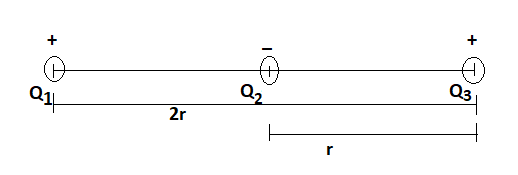
Three point charges ${{Q}_{1}}$,${{Q}_{2}}$,${{Q}_{3}}$are placed along a line at same distance apart. If ${{Q}_{1}}$and ${{Q}_{2}}$are opposite in nature and net force on ${{Q}_{3}}$is zero. Find magnitude of ${{Q}_{1}}$.
A.\[1\]
B.$\sqrt{2}$
C.$2{Q_2}$
D.$4{Q_2}$
Answer
219k+ views
Hint: When two objects have an electrical charge and exert an electric force on each other at a specific distance, the overall phenomena can be explained by Coulomb’s law. This law is also applicable for calculating net force since given three-point charges are equally spaced.
Formula used:
${{F}_{A,B}}=\dfrac{1}{4\pi {{\in }_{O}}}\dfrac{\left| {{q}_{A}}{{q}_{B}} \right|}{r_{AB}^{2}}$
Here ${{F}_{A,B}}=$ Electric force between two point charges ${{q}_{A}}$ and ${{q}_{B}}$
${{\in }_{O}}=$ constant = $8.85\times {{10}^{-12}}$${{C}^{2}}/N{{m}^{2}}$
${{r}_{AB}}=$ Distance between two-point charges ${{q}_{A}}$ and ${{q}_{B}}$
Complete answer:
First, we draw a possible diagram to explain the exerted force between the point charges.

According to the question, ${{Q}_{1}},{{Q}_{2}}$ ${{Q}_{3}}$point charges are placed along a straight line.
Let, ${{Q}_{1}}$ be a positive charge but ${{Q}_{2}}$ ${{Q}_{3}}$have the opposite sign. That means there exists an attractive force between ${{Q}_{2}}$and ${{Q}_{3}}$. But we have to keep the net force on ${{Q}_{3}}$is zero, that’s why the repulsive force acts between ${{Q}_{1}}$and ${{Q}_{3}}$.
Thus, the overall process reaches the equilibrium position as two forces that are attractive and repulsive must balance each other.
Applying Coulomb’s law between${{Q}_{1}}$ and ${{Q}_{3}}$ ,
${{F}_{1,3}}=\dfrac{1}{4\pi {{\in }_{0}}}\dfrac{{{Q}_{1}}{{Q}_{3}}}{r_{1,3}^{2}}$
Or, ${{F}_{1,3}}=\dfrac{1}{4\pi
{{\in }_{0}}}\dfrac{{{Q}_{1}}{{Q}_{3}}}{{{(2r)}^{2}}}$ [Since ${{r}_{1,3}}=2r$] …….(i)
And electric force between ${{Q}_{2}}$ and ${{Q}_{3}}$ ,
${{F}_{2,3}}=\dfrac{1}{4\pi {{\in }_{0}}}\dfrac{{{Q}_{2}}{{Q}_{3}}}{r_{2,3}^{2}}$
Or, ${{F}_{2,3}}=\dfrac{1}{4\pi
{{\in }_{0}}}\dfrac{{{Q}_{2}}{{Q}_{3}}}{{{(r)}^{2}}}$ [Since ${{r}_{2,3}}=r$] ……….(ii)
Due to the equilibrium conditions, ${{F}_{1,3}}=-{{F}_{2,3}}$ [Since $(-)$sign indicates the attaractive forces between $2$and $3$]
$\dfrac{1}{4\pi
{{\in }_{O}}}\dfrac{{{Q}_{1}}{{Q}_{3}}}{{{(2r)}^{2}}}=-\dfrac{1}{4\pi {{\in
}_{o}}}\dfrac{{{Q}_{2}}{{Q}_{3}}}{{{(r)}^{2}}}$
Or, $\dfrac{{{Q}_{1}}{{Q}_{3}}}{4{{r}^{2}}}=-\dfrac{{{Q}_{2}}{{Q}_{3}}}{{{r}^{2}}}$
Or,${{Q}_{1}}=-4{{Q}_{2}}$
Here also the minus (-) sign indicates the attractive forces between charge ${{Q}_{1}}$and ${{Q}_{2}}$.
Thus the charge of ${{Q}_{1}}$and ${{Q}_{2}}$ are opposite to each other
Therefore, (D) is the correct option.
Note:In this question three charges are placed on a line. So pay attention while assigning polarities to these three charges and also to displacement values between these charges. You should also understand the concept of repulsive and attentive electrostatic forces between charges.
Formula used:
${{F}_{A,B}}=\dfrac{1}{4\pi {{\in }_{O}}}\dfrac{\left| {{q}_{A}}{{q}_{B}} \right|}{r_{AB}^{2}}$
Here ${{F}_{A,B}}=$ Electric force between two point charges ${{q}_{A}}$ and ${{q}_{B}}$
${{\in }_{O}}=$ constant = $8.85\times {{10}^{-12}}$${{C}^{2}}/N{{m}^{2}}$
${{r}_{AB}}=$ Distance between two-point charges ${{q}_{A}}$ and ${{q}_{B}}$
Complete answer:
First, we draw a possible diagram to explain the exerted force between the point charges.

According to the question, ${{Q}_{1}},{{Q}_{2}}$ ${{Q}_{3}}$point charges are placed along a straight line.
Let, ${{Q}_{1}}$ be a positive charge but ${{Q}_{2}}$ ${{Q}_{3}}$have the opposite sign. That means there exists an attractive force between ${{Q}_{2}}$and ${{Q}_{3}}$. But we have to keep the net force on ${{Q}_{3}}$is zero, that’s why the repulsive force acts between ${{Q}_{1}}$and ${{Q}_{3}}$.
Thus, the overall process reaches the equilibrium position as two forces that are attractive and repulsive must balance each other.
Applying Coulomb’s law between${{Q}_{1}}$ and ${{Q}_{3}}$ ,
${{F}_{1,3}}=\dfrac{1}{4\pi {{\in }_{0}}}\dfrac{{{Q}_{1}}{{Q}_{3}}}{r_{1,3}^{2}}$
Or, ${{F}_{1,3}}=\dfrac{1}{4\pi
{{\in }_{0}}}\dfrac{{{Q}_{1}}{{Q}_{3}}}{{{(2r)}^{2}}}$ [Since ${{r}_{1,3}}=2r$] …….(i)
And electric force between ${{Q}_{2}}$ and ${{Q}_{3}}$ ,
${{F}_{2,3}}=\dfrac{1}{4\pi {{\in }_{0}}}\dfrac{{{Q}_{2}}{{Q}_{3}}}{r_{2,3}^{2}}$
Or, ${{F}_{2,3}}=\dfrac{1}{4\pi
{{\in }_{0}}}\dfrac{{{Q}_{2}}{{Q}_{3}}}{{{(r)}^{2}}}$ [Since ${{r}_{2,3}}=r$] ……….(ii)
Due to the equilibrium conditions, ${{F}_{1,3}}=-{{F}_{2,3}}$ [Since $(-)$sign indicates the attaractive forces between $2$and $3$]
$\dfrac{1}{4\pi
{{\in }_{O}}}\dfrac{{{Q}_{1}}{{Q}_{3}}}{{{(2r)}^{2}}}=-\dfrac{1}{4\pi {{\in
}_{o}}}\dfrac{{{Q}_{2}}{{Q}_{3}}}{{{(r)}^{2}}}$
Or, $\dfrac{{{Q}_{1}}{{Q}_{3}}}{4{{r}^{2}}}=-\dfrac{{{Q}_{2}}{{Q}_{3}}}{{{r}^{2}}}$
Or,${{Q}_{1}}=-4{{Q}_{2}}$
Here also the minus (-) sign indicates the attractive forces between charge ${{Q}_{1}}$and ${{Q}_{2}}$.
Thus the charge of ${{Q}_{1}}$and ${{Q}_{2}}$ are opposite to each other
Therefore, (D) is the correct option.
Note:In this question three charges are placed on a line. So pay attention while assigning polarities to these three charges and also to displacement values between these charges. You should also understand the concept of repulsive and attentive electrostatic forces between charges.
Recently Updated Pages
A square frame of side 10 cm and a long straight wire class 12 physics JEE_Main

The work done in slowly moving an electron of charge class 12 physics JEE_Main

Two identical charged spheres suspended from a common class 12 physics JEE_Main

According to Bohrs theory the timeaveraged magnetic class 12 physics JEE_Main

ill in the blanks Pure tungsten has A Low resistivity class 12 physics JEE_Main

The value of the resistor RS needed in the DC voltage class 12 physics JEE_Main

Trending doubts
JEE Main 2026: Application Form Open, Exam Dates, Syllabus, Eligibility & Question Papers

Understanding Uniform Acceleration in Physics

Derivation of Equation of Trajectory Explained for Students

Hybridisation in Chemistry – Concept, Types & Applications

Understanding the Angle of Deviation in a Prism

Understanding Collisions: Types and Examples for Students

Other Pages
JEE Advanced Marks vs Ranks 2025: Understanding Category-wise Qualifying Marks and Previous Year Cut-offs

Understanding Atomic Structure for Beginners

How to Convert a Galvanometer into an Ammeter or Voltmeter

Understanding Centrifugal Force in Physics

JEE Main Marking Scheme 2026- Paper-Wise Marks Distribution and Negative Marking Details

Degree of Dissociation: Meaning, Formula, Calculation & Uses




